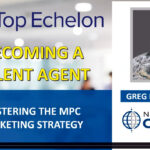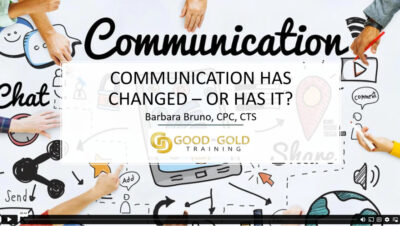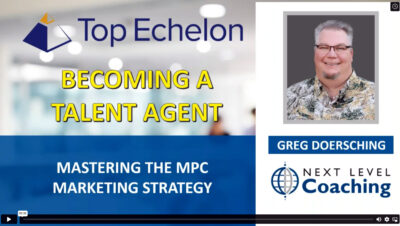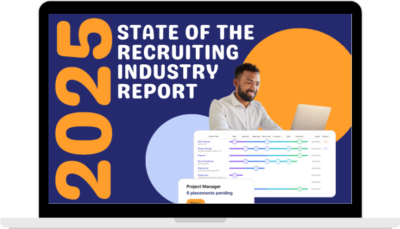(Editor’s note: The information from this article by Top Echelon Recruiting Software has been taken from an Expert Recruiter Coaching Series webinar by Barb Bruno, CPC/CTS of Good as Gold Training titled, “Communication Has Changed . . . or Has It?” Click HERE to watch the video of that training webinar for free.)
In today’s always-on digital world, it’s tempting to declare that communication is broken. Recruiters bemoan unanswered calls, unopened emails, and ghosted conversations. But according to Barb Bruno—international trainer, author of High-Tech High-Touch Recruiting, and a LinkedIn Learning instructor with access to the platform’s massive data sets—the problem isn’t that communication has changed. The problem is that too many recruiters have stopped communicating well.
“People may not remember what you said, but they’ll always remember how you made them feel,” Bruno told a live webinar audience. And that’s the crux of the issue: technology has given us new ways to reach out, but it hasn’t changed the fundamental need for human connection.
This article dives into Bruno’s insights, offering a detailed, actionable guide for modern recruiters struggling to break through the digital noise. Communication hasn’t disappeared—it’s just waiting to be done right.
Yes, People Still Answer the Phone
Bruno began the webinar by addressing the elephant in the room: “Does anybody really answer their phone anymore?”
“Yes,” she said emphatically. “If candidates or clients understand how you can benefit them, they will answer the phone. They’ll acknowledge your email. They’ll even respond to your InMail.”
But here’s the catch: if they don’t see the benefit, they won’t respond—and it’s not because they’re rude or lazy. “When they don’t talk to you,” Bruno explained, “they feel you sound like everyone else. They see no difference in talking to you or any other recruiter.”
This should be a wake-up call for recruiters still relying on generic, templated outreach. It’s not that communication is dead—it’s that differentiation is. Recruiters who sound like copy-and-paste salespeople are ignored. Recruiters who provide personalized value get responses.
Technology Doesn’t Place People—You Do
Barb Bruno’s firm is entirely paperless and highly automated. But she doesn’t confuse automation with relationship building. “Computers don’t make placements. People do,” she said. “Recruiting has been, is, and always will be a relationship business.”
She acknowledges the power of tools like AI and ChatGPT but reminds us that they’re designed to enhance—not replace—human communication. “You can’t build lifetime relationships with candidates or become a trusted adviser to your clients if you only communicate utilizing technology.”
Even the dating world supports this view. “Even people who use dating sites eventually meet,” she quipped. The point? Sooner or later, real conversations matter.
If you want to evaluate how well you’re building relationships, Bruno offers three revealing metrics:
-
What percentage of your placed candidates are referrals? If you’ve been in the profession for more than 18 months, it should be at least 40%.
-
What percentage of contractors do you redeploy? Industry average is below 10%, but top firms redeploy 50% or more.
-
What percentage of your new clients come from referrals? Again, the target is 40% or higher.
“If you’re not hitting those numbers,” she said, “you don’t have the relationships you think you have.”
High-Tech Must Be Matched with High-Touch
When Bruno was asked to write a book by Kogan Page Publishing, the topic was clear: human interaction. “They wanted a book that nobody else had written,” she said. That book became High-Tech High-Touch Recruiting.
“Yes, we use technology,” she explained. “But it has to be a combination. High-tech and high-touch.”
The real power lies in knowing when to lean into tech and when to get personal. Effective communication isn’t just about reaching someone—it’s about making them feel seen, heard, and valued.
Stop Pitching So Fast
One of Bruno’s most urgent warnings to recruiters? Slow down. “I never thought I’d say that,” she admitted, “because I move fast. But we’ve got to slow down with candidates.”
Too many recruiters are rushing to pitch jobs before understanding the person. “How can you sell when you don’t understand their priorities and challenges?” she asked. “Don’t assume that what someone is doing now is what they want to do next.”
She emphasized the importance of asking open-ended, future-focused questions like:
“What do you see as your next career move?”
Rather than pitching a role right away, suggest a conversation:
“I’d love to discuss your career advancement and what’s important to you—not just a specific job.”
That small shift in tone makes a massive difference in how candidates perceive your intentions.
Five Barriers to Communication You Might Not Even Notice
Bruno outlined five common traps that sabotage recruiter communication:
-
Pitching Too Soon – “Don’t assume,” she said. “That line, ‘I saw your LinkedIn profile and have the perfect job’ is the one candidates hate the most.”
-
Interrupting – Reacting before someone finishes talking cuts off rapport before it starts.
-
Not Listening – “Hearing and listening are two different skill sets,” Bruno said. “You need 100% focus.”
-
Not Writing It Down – “Every conversation should be documented in your ATS,” she stressed. “You can’t follow up properly if you don’t remember what they said.”
-
External Distractions – Working from home? Be careful. “One morning I looked at ripe bananas and baked banana bread instead of working,” she confessed, with a laugh. “Distractions are real.”
Emails Aren’t Dead—They’re Just Misused
According to LinkedIn, 82% of all emails go unopened. That’s a sobering statistic. The reasons? Weak subject lines, impersonal senders, and overly generic content.
Bruno offered this advice:
-
Use your own name instead of a company alias—it increases open rates by 33%.
-
Craft subject lines that are 6–10 words long and tap into curiosity.
-
Analyze what subject lines you open and replicate that strategy.
One of her best-performing subject lines?
“Bruno: Answer to your question”
Why does it work? It’s personal, implies value, and creates a natural desire to click.
Bruno also advised checking your own inbox habits. “Look at what you open and what you delete. That will tell you what works.”
Tame Your Inbox: Respond to Email Three Times a Day
Constant email checking is killing recruiter productivity, Bruno argued. “Incoming email usually represents the priorities of others—not your own,” she warned.
Unless you’re in a fast-paced temp placement environment, she recommends checking email only three times per day:
-
Early morning
-
Midday
-
End of day
Then, let clients and candidates know why. Tell candidates:
“During the day, I’m marketing your skills to my best clients.”
And tell clients:
“During the day, I’m focused on surfacing top talent for your openings.”
“They love the option to interrupt you,” she said, “but they rarely use it.” Meanwhile, you reclaim 60–90 minutes of focused time daily.
Voicemail Isn’t Dead—You’re Just Using It Wrong
Voicemail returns are abysmal in most firms—less than 5%. But Bruno’s team sees returns of over 150%, thanks to one change: they stopped sounding like salespeople.
A typical recruiting voicemail?
“Hi, I saw your profile and have the perfect job…”
This tells the listener: I’m a salesperson. I want something.
Bruno’s version, by contrast, makes the recipient feel important and curious:
“My name is Barb Bruno. My number is [###]. Someone suggested we talk. When you call back, please tell whoever answers the phone to interrupt me so I don’t miss your call. I’m really looking forward to our conversation.”
What makes it work?
-
It positions the recipient as important.
-
It sounds like a personal connection.
-
It creates curiosity (who recommended them?).
-
It avoids the dreaded sales pitch.
When prospects call back and say, “Barb told you to interrupt her,” Bruno knows it’s a recruiting hit.
Write Messages That Make People Feel Something
Bruno shared a guiding principle: “Every message should answer WIIFM—‘What’s In It For Me?’”
Whether it’s email, voicemail, or InMail, the message must make the candidate or client feel like there’s something in it for them—a solution, a benefit, a chance at something better.
Here are a few examples of effective InMails:
For Clients:
“In the past 90 days, I’ve helped 7 companies like yours hire top engineering talent who became engaged and retained employees. When would it be convenient for us to discuss your hiring challenges?”
The phrase “engaged and retained” is especially powerful, Bruno noted, because those are major pain points for HR leaders today.
For Candidates:
“I’ve helped 12 professionals with experience similar to yours achieve both short- and long-term goals. When would it be convenient to discuss what you’d like to achieve in your career?”
This positions the recruiter as a career agent, not a job pusher.
One more tip: Instead of asking people who they know, ask:
“Who was the best [job title] from your last place of employment?”
That small tweak triples referral rates and creates more meaningful leads.
Get Referrals—And Track Them
Strong communication leads to referrals—but only if you ask.
“Every one of your clients knows another client who could use your services,” Bruno said. “But if they’re not referring, it’s because you haven’t asked—or you’re not filling all their jobs.”
Bruno’s firm even incentivizes referrals:
-
For candidates, a simple gift card or a drawing for a bigger prize (like a trip) works wonders.
-
For clients, they donate to a favorite charity in the client’s name. This approach increased client referrals by 355%.
It’s Not a Job. It’s a Career.
To close, Bruno reminded recruiters that great communication isn’t just a “nice-to-have”—it’s the key to long-term success.
“This is not a job,” she said. “This is a career. And you get out of it what you put into it.”
Improving your communication—whether verbal or written—will increase response rates, build stronger relationships, and drive more revenue. But more than that, it will make you stand out in an industry where most recruiters are still stuck in transactional mode.
If you want to know whether your communication is working, just ask yourself:
Are you getting referrals?
Are your candidates calling you back?
Do your clients see you as a vendor—or as a partner?
If the answer isn’t clear, it’s time to change the way you talk—and more importantly, the way you make people feel.
Because in the end, communication hasn’t changed.
But how well you do it still makes all the difference.
Your Next Steps:
-
Audit your recent voicemails, emails, and InMails for value and personalization.
-
Use Bruno’s voicemail script and measure your callback rate.
-
Rework your outreach to focus on WIIFM (What’s In It For Me?).
-
Ask every candidate: “What do you see as your next move?”
-
Ask every client: “How can I improve how you attract and retain top talent?”
You won’t just learn how to communicate. You’ll learn how to connect—and that’s what recruiting has always been about.









